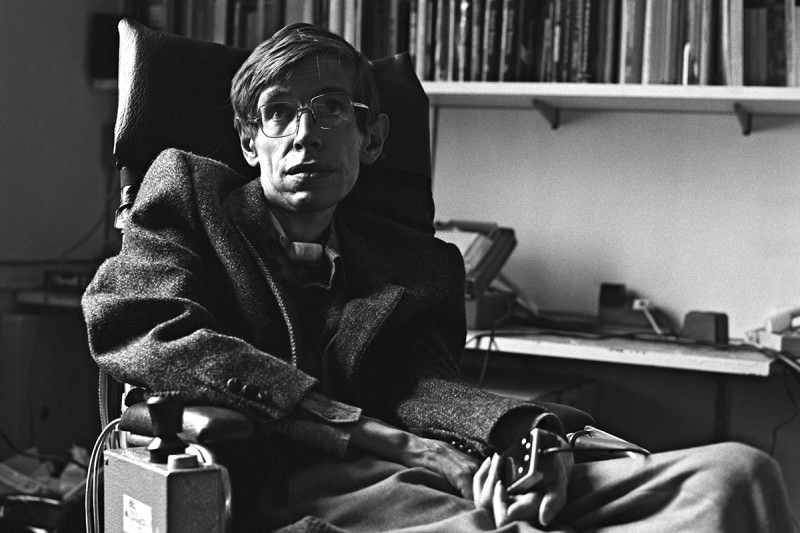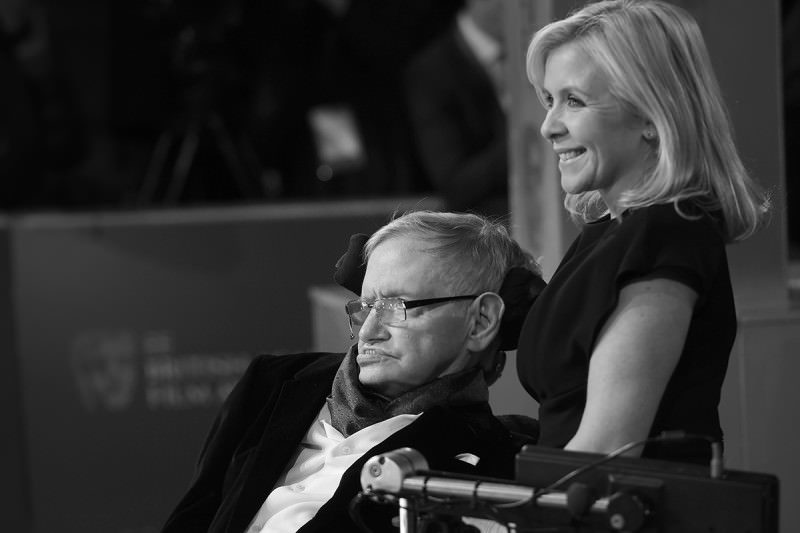Hawking's children, Lucy, Robert and Tim said in a statement: "We are deeply saddened that our beloved father passed away today.
"He was a great scientist and an extraordinary man whose work and legacy will live on for many years. His courage and persistence with his brilliance and humour inspired people across the world.
"He once said: 'It would not be much of a universe if it wasn't home to the people you love.' We will miss him for ever."
The most recognisable scientist of our age, Hawking holds an iconic status. His genre-defining book, A Brief History of Time, has sold more than 10 million copies since its publication in 1988, and has been translated into more than 35 languages. He appeared on Star Trek: The Next Generation, The Simpsons and The Big Bang Theory. His early life was the subject of an Oscar-winning performance by Eddie Redmayne in the 2014 film The Theory of Everything. He was routinely consulted for oracular pronouncements on everything from time travel and alien life to Middle Eastern politics and nefarious robots. He had an endearing sense of humour and a daredevil attitude - relatable human traits that, combined with his seemingly superhuman mind, made Hawking eminently marketable.
But his cultural status - amplified by his disability and the media storm it invoked - often overshadowed his scientific legacy. That's a shame for the man who discovered what might prove to be the key clue to the theory of everything, advanced our understanding of space and time, helped shape the course of physics for the last four decades and whose insight continues to drive progress in fundamental physics today.
Beginning with the big bang
Hawking's research career began with disappointment. Arriving at the University of Cambridge in 1962 to begin his PhD, he was told that Fred Hoyle, his chosen supervisor, already had a full complement of students. The most famous British astrophysicist at the time, Hoyle was a magnet for the more ambitious students. Hawking didn't make the cut. Instead, he was to work with Dennis Sciama, a physicist Hawking knew nothing about. In the same year, Hawking was diagnosed with amyotrophic lateral sclerosis, a degenerative motor neurone disease that quickly robs people of the ability to voluntarily move their muscles. He was told he had two years to live.
Although Hawking's body may have weakened, his intellect stayed sharp. Two years into his PhD, he was having trouble walking and talking, but it was clear that the disease was progressing more slowly than the doctors had initially feared. Meanwhile, his engagement to Jane Wilde - with whom he later had three children, Robert, Lucy and Tim - renewed his drive to make real progress in physics.
Working with Sciama had its advantages. Hoyle's fame meant that he was seldom in the department, whereas Sciama was around and eager to talk. Those discussions stimulated the young Hawking to pursue his own scientific vision. Hoyle was vehemently opposed to the big bang theory (in fact, he had coined the name "big bang" in mockery). Sciama, on the other hand, was happy for Hawking to investigate the beginning of time.
Time's arrow
Hawking was studying the work of Roger Penrose, which proved that if Einstein's general theory of relativity is correct, at the heart of every black hole must be a point where space and time themselves break down - a singularity. Hawking realised that if time's arrow were reversed, the same reasoning would hold true for the universe as a whole. Under Sciama's encouragement, he worked out the maths and was able to prove it: the universe according to general relativity began in a singularity.
Hawking was well aware, however, that Einstein didn't have the last word. General relativity, which describes space and time on a large scale, doesn't take into account quantum mechanics, which describes matter's strange behaviour at much smaller scales. Some unknown "theory of everything" was needed to unite the two. For Hawking, the singularity at the universe's origin did not signal the breakdown of space and time; it signalled the need for quantum gravity.
Luckily, the link that he forged between Penrose's singularity and the singularity at the big bang provided a key clue for finding such a theory. If physicists wanted to understand the origin of the universe, Hawking had just shown them exactly where to look: a black hole.
Black holes were a subject ripe for investigation in the early 1970s. Although Karl Schwarzschild had found such objects lurking in the equations of general relativity back in 1915, theoreticians viewed them as mere mathematical anomalies and were reluctant to believe they could actually exist.
Albeit frightening, their action is reasonably straightforward: black holes have such strong gravitational fields that nothing, not even light, can escape their grip. Any matter that falls into one is forever lost to the outside world. This, however, is a dagger in the heart of thermodynamics.
Thermodynamic threat
The second law of thermodynamics is one of the most well-established laws of nature. It states that the entropy, or level of disorder in a system, always increases. The second law gives form to the observation that ice cubes will melt into a puddle, but a puddle of water will never spontaneously turn into a block of ice. All matter contains entropy, so what happens when it is dropped into a black hole? Is entropy lost along with it? If so, the total entropy of the universe goes down and black holes would violate the second law of thermodynamics.
Hawking thought that this was fine. He was happy to discard any concept that stood in the way to a deeper truth. And if that meant the second law, then so be it.
Bekenstein and breakthrough
But Hawking met his match at a 1972 physics summer school in the French ski resort of Les Houches, France. Princeton University graduate student Jacob Bekenstein thought that the second law of thermodynamics should apply to black holes too. Bekenstein had been studying the entropy problem and had reached a possible solution thanks to an earlier insight of Hawking's.
A black hole hides its singularity with a boundary known as the event horizon. Nothing that crosses the event horizon can ever return to the outside. Hawking's work had shown that the area of a black hole's event horizon never decreases over time. What's more, when matter falls into a black hole, the area of its event horizon grows.
Bekenstein realised this was key to the entropy problem. Every time a black hole swallows matter, its entropy appears to be lost, and at the same time, its event horizon grows. So, Bekenstein suggested, what if - to preserve the second law - the area of the horizon is itself a measure of entropy?
Hawking immediately disliked the idea and was angry that his own work had been used in support of a concept so flawed. With entropy comes heat, but the black hole couldn't be radiating heat - nothing can escape its pull of gravity. During a break from the lectures, Hawking got together with colleagues Brandon Carter, who also studied under Sciama, and James Bardeen, of the University of Washington, and confronted Bekenstein.
The disagreement bothered Bekenstein. "These three were senior people. I was just out of my PhD. You worry whether you are just stupid and these guys know the truth," he recalls.
Back in Cambridge, Hawking set out to prove Bekenstein wrong. Instead, he discovered the precise form of the mathematical relationship between entropy and the black hole's horizon. Rather than destroying the idea, he had confirmed it. It was Hawking's greatest breakthrough.
Hawking radiation
Hawking now embraced the idea that thermodynamics played a part in black holes. Anything that has entropy, he reasoned, also has a temperature - and anything that has a temperature can radiate.
His original mistake, Hawking realised, was in only considering general relativity, which says that nothing - no particles, no heat - can escape the grip of a black hole. That changes when quantum mechanics comes into play. According to quantum mechanics, fleeting pairs of particles and antiparticles are constantly appearing out of empty space, only to annihilate and disappear in the blink of an eye. When this happens in the vicinity of an event horizon, a particle-antiparticle pair can be separated - one falls behind the horizon while one escapes, leaving them forever unable to meet and annihilate. The orphaned particles stream away from the black hole's edge as radiation. The randomness of quantum creation becomes the randomness of heat.
"I think most physicists would agree that Hawking's greatest contribution is the prediction that black holes emit radiation," says Sean Carroll, a theoretical physicist at the California Institute of Technology. "While we still don't have experimental confirmation that Hawking's prediction is true, nearly every expert believes he was right."
Experiments to test Hawking's prediction are so difficult because the more massive a black hole is, the lower its temperature. For a large black hole - the kind astronomers can study with a telescope - the temperature of the radiation is too insignificant to measure. As Hawking himself often noted, it was for this reason that he was never awarded a Nobel Prize. Still, the prediction was enough to secure him a prime place in the annals of science, and the quantum particles that stream from the black hole's edge would forever be known as Hawking radiation.
Some have suggested that they should more appropriately be called Bekenstein-Hawking radiation, but Bekenstein himself rejects this. "The entropy of a black hole is called Bekenstein-Hawking entropy, which I think is fine. I wrote it down first, Hawking found the numerical value of the constant, so together we found the formula as it is today. The radiation was really Hawking's work. I had no idea how a black hole could radiate. Hawking brought that out very clearly. So that should be called Hawking radiation."
Theory of everything
The Bekenstein-Hawking entropy equation is the one Hawking asked to have engraved on his tombstone. It represents the ultimate mash-up of physical disciplines because it contains Newton's constant, which clearly relates to gravity; Planck's constant, which betrays quantum mechanics at play; the speed of light, the talisman of Einstein's relativity; and the Boltzmann constant, the herald of thermodynamics.
The presence of these diverse constants hinted at a theory of everything, in which all physics is unified. Furthermore, it strongly corroborated Hawking's original hunch that understanding black holes would be key in unlocking that deeper theory.
Hawking's breakthrough may have solved the entropy problem, but it raised an even more difficult problem in its wake. If black holes can radiate, they will eventually evaporate and disappear. So what happens to all the information that fell in? Does it vanish too? If so, it will violate a central tenet of quantum mechanics. On the other hand, if it escapes from the black hole, it will violate Einstein's theory of relativity. With the discovery of black hole radiation, Hawking had pit the ultimate laws of physics against one another. The black hole information loss paradox had been born.
Hawking staked his position in another ground-breaking and even more contentious paper entitled Breakdown of predictability in gravitational collapse, published in Physical Review D in 1976. He argued that when a black hole radiates away its mass, it does take all of its information with it - despite the fact that quantum mechanics expressly forbids information loss. Soon other physicists would pick sides, for or against this idea, in a debate that continues to this day. Indeed, many feel that information loss is the most pressing obstacle in understanding quantum gravity.
"Hawking's 1976 argument that black holes lose information is a towering achievement, perhaps one of the most consequential discoveries on the theoretical side of physics since the subject was invented," says Raphael Bousso of the University of California, Berkeley.
Concession
By the late 1990s, results emerging from string theory had most theoretical physicists convinced that Hawking was wrong about information loss, but Hawking, known for his stubbornness, dug in his heels. It wasn't until 2004 that he would change his mind. And he did it with flair - dramatically showing up at a conference in Dublin and announcing his updated view: black holes cannot lose information.
Today, however, a new paradox known as the firewall has thrown everything into doubt (see "Hawking's paradox", below). It is clear that the question Hawking raised is at the core of the quest for quantum gravity.
"Black hole radiation raises serious puzzles we are still working very hard to understand," says Carroll. "It's fair to say that Hawking radiation is the single biggest clue we have to the ultimate reconciliation of quantum mechanics and gravity, arguably the greatest challenge facing theoretical physics today."
Hawking's legacy, says Bousso, will be "having put his finger on the key difficulty in the search for a theory of everything".
Hawking continued pushing the boundaries of theoretical physics at a seemingly impossible pace for the rest of his life. He made important inroads towards understanding how quantum mechanics applies to the universe as a whole, leading the way in the field known as quantum cosmology. His progressive disease pushed him to tackle problems in novel ways, which contributed to his remarkable intuition for his subject. As he lost the ability to write out long, complicated equations, Hawking found new and inventive methods to solve problems in his head, usually by reimagining them in geometric form. But, like Einstein before him, Hawking never produced anything quite as revolutionary as his early work.
"Hawking's most influential work was done in the 1970s, when he was younger," says Carroll, "but that's completely standard even for physicists who aren't burdened with a debilitating neurone disease."
Hawking the superstar
In the meantime, the publication of A Brief History of Time catapulted Hawking to cultural stardom and gave a fresh face to theoretical physics. He never seemed to mind. "In front of the camera, Hawking played the character of Hawking. He seemed to play with his cultural status," says Hélène Mialet, an anthropologist from the University of California, Berkeley, who courted controversy in 2012 with the publication of her book Hawking Incorporated. In it, she investigated the way the people around Hawking helped him build and maintain his public image.
That public image undoubtedly made his life easier than it might otherwise have been. As Hawking's disease progressed, technologists gladly provided increasingly complicated machines to allow him to communicate. This, in turn, let him continue doing the thing for which he should ultimately be remembered: his science.
"Stephen Hawking has done more to advance our understanding of gravitation than anyone since Einstein," Carroll says. "He was a world-leading theoretical physicist, clearly the best in the world for his time among those working at the intersection of gravity and quantum mechanics, and he did it all in the face of a terrible disease. He is an inspirational figure, and history will certainly remember him that way."
Hawking's paradox
In 2012, four physicists at the University of California, Santa Barbara - Ahmed Almheiri, Donald Marolf, Joseph Polchinski and James Sully, known collectively by physicists as AMPS - shocked the physics community with the results of a thought experiment.
When pairs of particles and antiparticles spawn near a black hole's event horizon, each pair shares a connection called entanglement. But what happens to this link and the information it holds when one of the pair falls in, leaving its twin to become a particle of Hawking radiation (see main story)?
One school of thought holds that the information is preserved as the hole evaporates, and that it is placed into subtle correlations among these particles of Hawking radiation.
But, AMPS asked, what does it look like to observers inside and outside the black hole? Enter Alice and Bob.
According to Bob, who remains outside the black hole, that particle has been separated from its antiparticle partner by the horizon. In order to preserve information, it must become entangled with another particle of Hawking radiation.
But what's happening from the point of view of Alice, who falls into the black hole? General relativity says that for a free-falling observer, gravity disappears, so she doesn't see the event horizon. According to Alice, the particle in question remains entangled with its antiparticle partner, because there is no horizon to separate them. The paradox is born.
So who is right? Bob or Alice? If it's Bob, then Alice will not encounter empty space at the horizon as general relativity claims. Instead she will be burned to a crisp by a wall of Hawking radiation - a firewall. If it's Alice who's right, then information will be lost, breaking a fundamental rule of quantum mechanics. "The fervent controversy surrounding Hawking's paradox reflects the stakes his work has raised: in quantising gravity, what gives? And how much?" says Raphael Bousso of the University of California, Berkeley. The answer awaits us in the theory of everything.






by Miles Mathis
First published April 17, 2015
[Link]